Are you looking to export your WooCommerce orders to Excel format?
While CSV and XML formats are frequently used, they come with a few limitations. In some cases, you may specifically need to work with Excel files to perform detailed analysis or generate comprehensive reports.
In this article, we’ll guide you through the process of exporting your WooCommerce orders to Excel format quickly and efficiently.
Limitations of Using CSV for Order Export
WooCommerce includes a built-in order exporting tool that provides order data in CSV format. While this tool works out of the box without requiring any third-party plugins, it offers very limited data, which may not be sufficient for comprehensive analysis or reporting.
There are also many third-party WooCommerce export plugins that offer more data, these often restrict you to CSV and XML files.
CSV format comes with several limitations, such as:
- Limited Data Structure
CSV files are flat and may not support complex data structures such as formulas, macros, pivot tables, or advanced visualization options. This makes working with them difficult. - Compatibility Issues
While CSV is widely supported, not all platforms handle CSV files in the same way, which can lead to compatibility issues. This can make it difficult to integrate your data seamlessly across different systems. - Manual Adjustments
CSV files often require manual adjustments to be useful. You might need to reformat the data, add missing fields, or correct errors. This process can be time-consuming and prone to mistakes.
Unlike CSV files, exporting to Excel format allows you to maintain formatting and use powerful data manipulation tools for more robust data analysis. Additionally, Excel is a widely supported file format, which ensures compatibility across various platforms.
WP All Export- Best WooCommerce Order Export Plugin for Excel Format
When it comes to exporting WooCommerce orders to Excel, the WP All Export plugin stands out as the best option. This comprehensive and user-friendly plugin allows you to effortlessly export your WooCommerce orders to Excel in both .xls and .xlsx file formats.
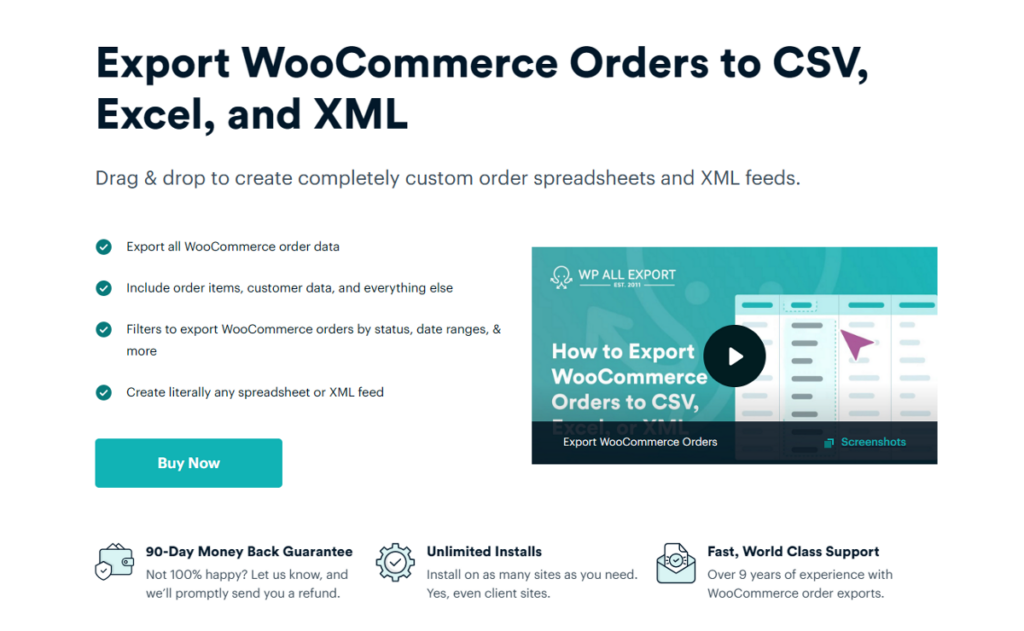
It comes with an intuitive drag-and-drop interface that makes the whole export process seamless.
Another great advantage of WP All Export is its extensive data customization options. It allows you to easily manipulate the data on the fly, customize columns by combining multiple fields into one, or present multi-value fields in separate columns. This reduces the need for manual adjustments later on, providing you with a ready-to-use export file with minimal effort.
Some other benefits of using WP All Export are:
- Advanced filtering using AND and OR logic to get the exact order data you need.
- Support for all WooCommerce order fields, including custom fields.
- Create recurring scheduled exports.
- Connect to over 5,000 third-party tools via Zapier integration.
- Enable real-time exports that are completed as orders are placed.
- Save export settings to use as a template for future exports.
How to Quickly Export WooCommerce Orders to Excel Format
Once you’ve installed the premium version of the WP All Export plugin, it only takes a couple of minutes to generate order export in Excel format. The plugin features an export wizard that simplifies the entire process into four easy steps.
Let’s explore these steps in detail.
1. Create a New WooCommerce Order Export and Filter Your Data
To start your export, go to All Export › New Export and select “WooCommerce Orders” as the export type.
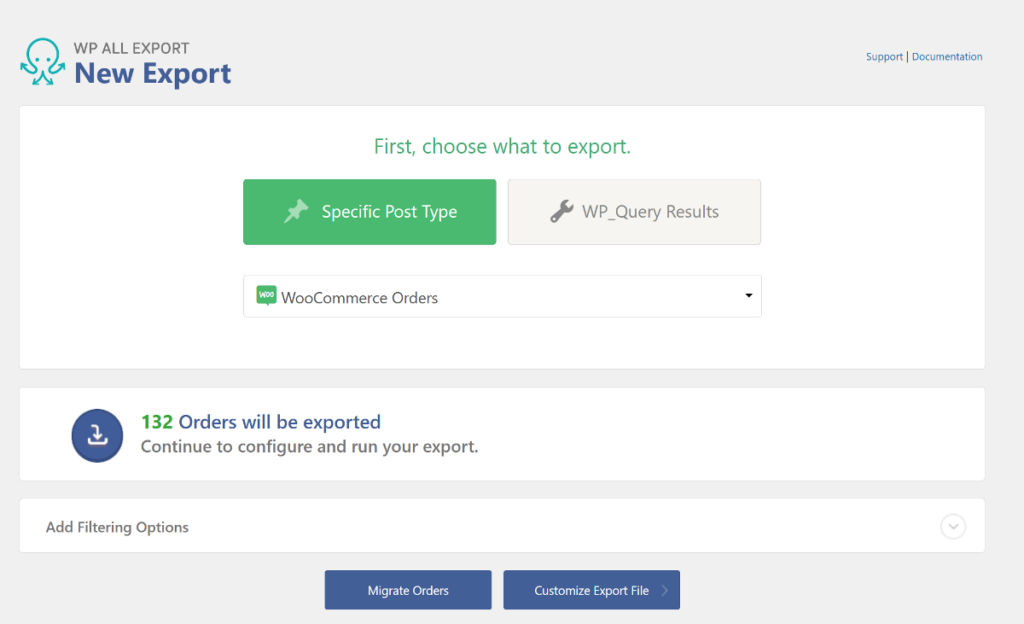
WP All Export will scan your database and display the total number of orders available for export.
However, not everyone wants to export their entire order database. WP All Export comes with advanced filtering options to help you export only a subset of your orders that you need.
On the same page, expand the Add Filtering Options panel near the bottom.
For each rule, you’ll need to add three components: Element, Rule, and Value. For Element and Rule, click the box to select your choice from the dropdown menu. In the final field, enter the value you want to filter by.
After you’ve added all three components, your export filter should look like this.

Next, click the Add Rule button to filter all orders based on the values you’ve specified.
WP All Export also allows you to create complex filters by combining rules using AND or OR logic.
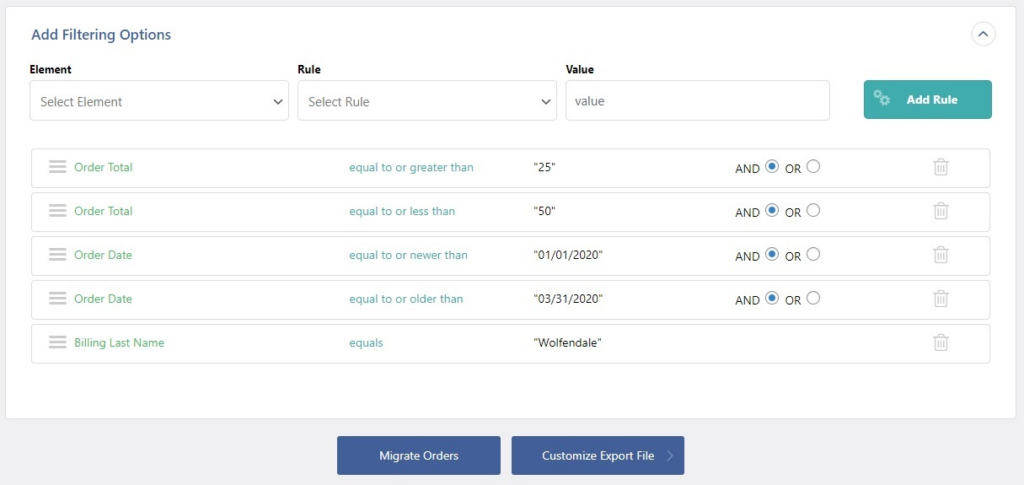
For example, the filters we added in the screenshot select all orders with an Order Total between $25 and $50, an Order Date between January 1, 2020, and March 31, 2020, and a Billing Last Name of “Wolfendale.”
Once you have set the filters, click the Customize Export File button to proceed to the next step.
2. Select the Order Fields You Want To Export and Change File Format
WP All Export features a drag-and-drop field selector that makes it easy to choose the exact fields you want to export.
You can expand the various order-related field tabs located under the Available Data section on the right-hand side.
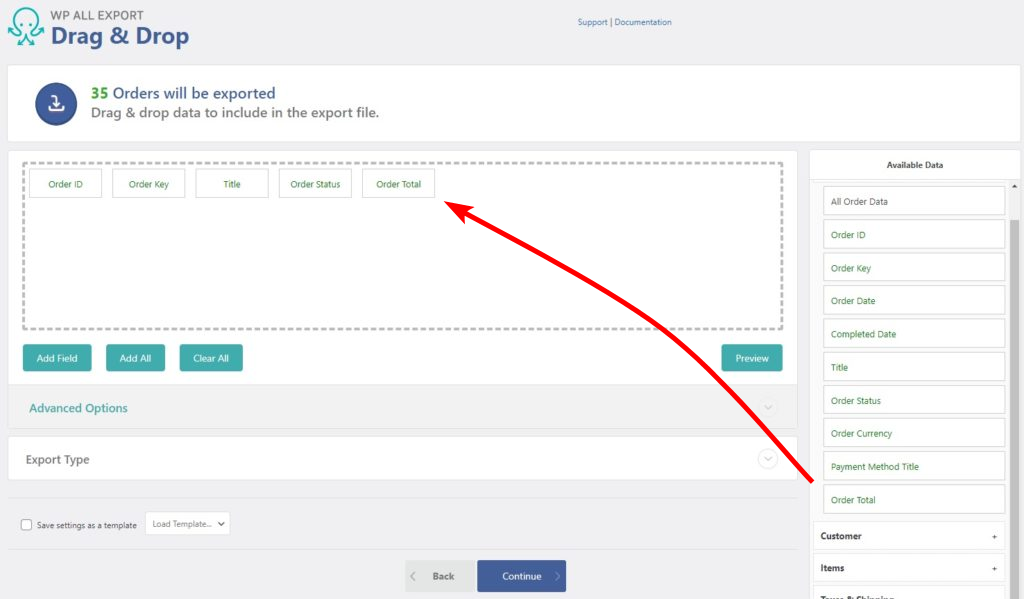
The order field categories include:
- Order
- Customer Details
- Items
- Taxes & Shipping
- Fees & Discounts
- Notes
- Refunds
- Custom fields
You can also use the same interface to rearrange or remove fields from the selection area.
When it comes to advanced features, it lets you easily combine two fields into one column or present multi-value fields in separate columns.
Let’s look at an example of how to combine the first name and last name fields into a single “Customer Name” column.
- Click the Add Field button below the selection area.
- In the popup window, select the Custom export field option. This will bring up the Available Data panel on the right.
- In the panel, expand the Customer tab.
- Drag the [Billing First Name] and [Billing Last Name] in the Custom export field area.
- Put a space between the two fields.
- Type “Customer Name” in the Column name box.
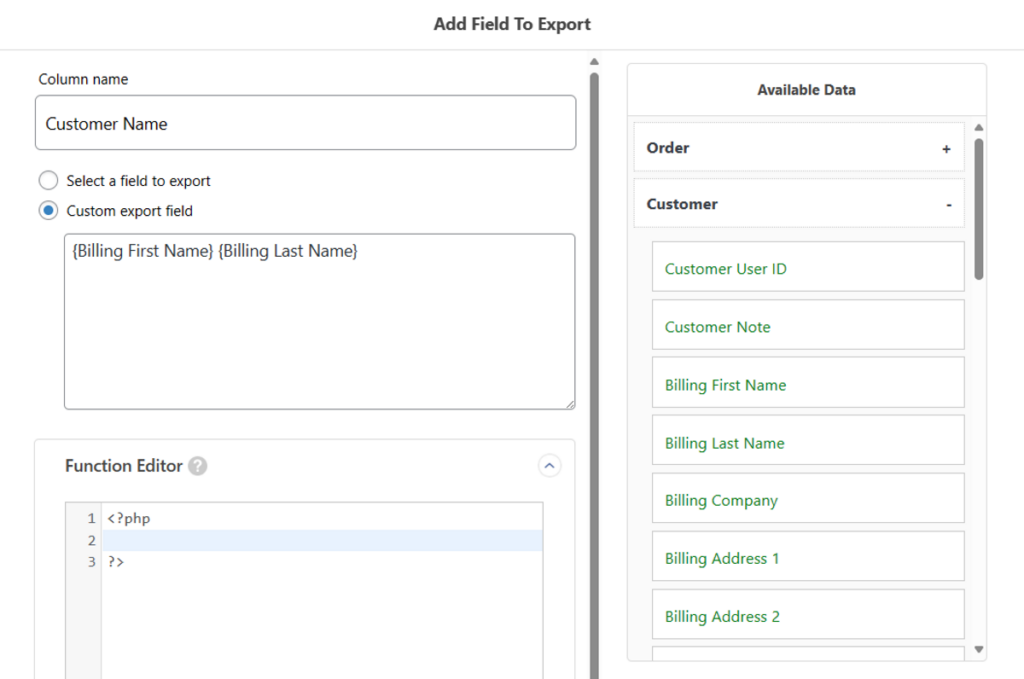
- Click the Preview button to see how it will look in the exported file, and then click the Save button to add it to the export file.
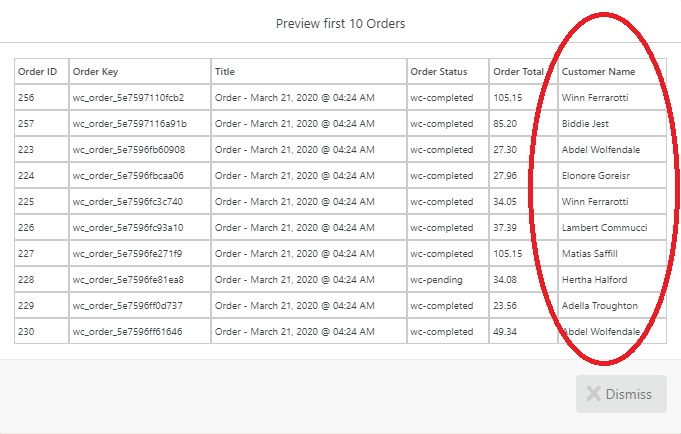
That’s not all! WP All Export also supports custom code, allowing you to customize the data using conditional logic, PHP operators, and calculations.
This means you can easily manipulate the export data, such as changing city names to their abbreviations and much more.
Change Export File Format to Excel
WP All Export supports exporting orders to various file formats, including Excel (XLSX or XLS), CSV, and XML. The default type is set to CSV, but you can easily change it to Excel format.
On the same page, expand the Export Type panel near the bottom of the screen.
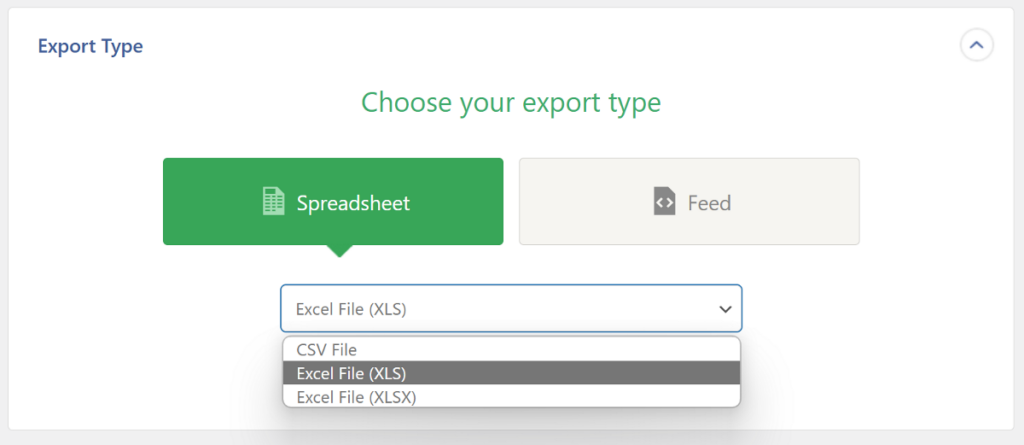
In the panel that appears, click the Spreadsheet option and choose either Excel File (XLSX) or Excel File (XLS) from the dropdown, depending on the format you want to export.
Once done, click Continue to move to the next step.
3. Schedule WooCommerce Order Exports and Configure Advanced Options
One of the standout features of WP All Export is the ability to create recurring exports that run on a fixed schedule. This is particularly valuable when you need to automatically send Excel files to a third-party tool without manual intervention.
Set Excel Export Schedule
To schedule your Excel export, follow these steps:
- Expand the Scheduling Options panel on the Export Settings screen.
- You have two options for scheduling your exports: you can either use the paid Automatic Scheduling option or set up cron jobs on your server.
- We’ll select the Automatic Scheduling option. Then, set the schedule to run every week or every month.
- Choose the time and select the timezone for performing automatic exports.
Your scheduling options should look like this.
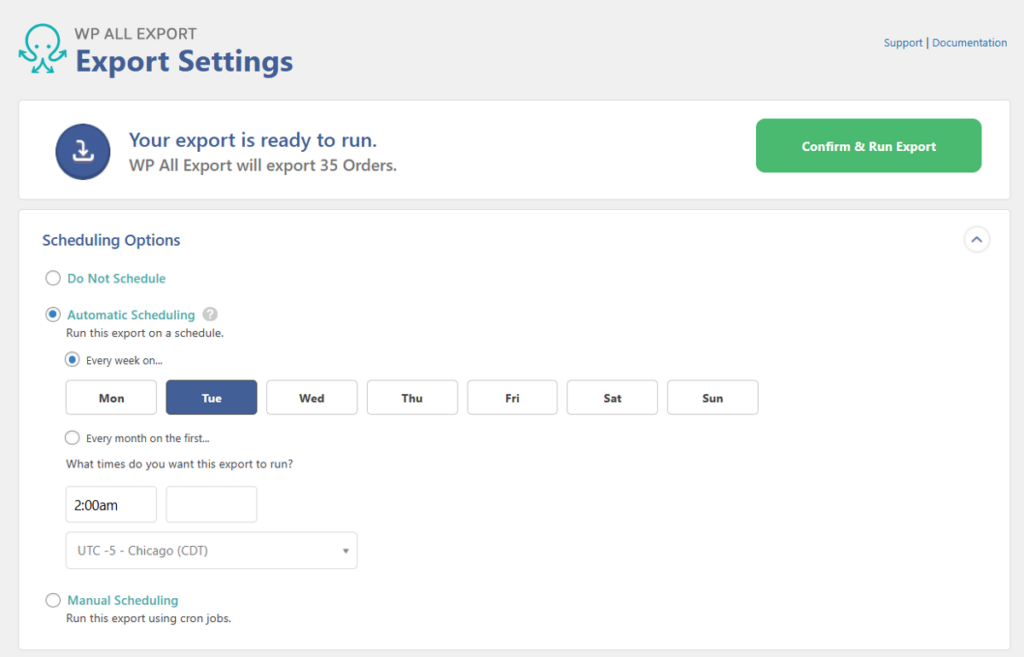
This configuration means that your order export will run at 2:00 a.m. Chicago time (UTC -5) every Tuesday.
Configure Advanced Options
In addition to scheduling, WP All Export includes advanced features such as real-time exports that activate as soon as orders are placed.
When connected to Zapier, this feature allows you to integrate with over 5,000 third-party tools. This means you can automatically add new orders to Microsoft Excel as they are placed on your website.
Most of the advanced export options are straightforward and presented as simple checkboxes. These options include:
- Run order exports in real-time as they are completed.
- If you re-run the export in the future, only export orders that have been newly created or modified since the previous export.
- Include BOM to help Excel properly read your export file.
- Create a new export file each time you run the export instead of overwriting the existing file.
- If you have a large number of records, split the export file into multiple files.
- Role permission to allow non-admin roles to export the file.
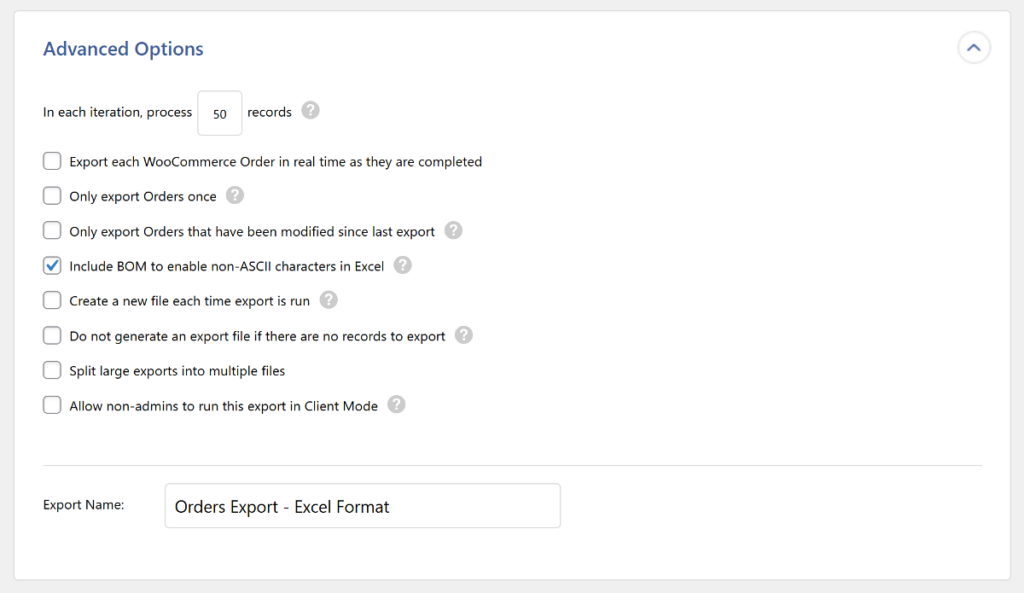
You can read our dedicated article on advanced export settings to learn more about each option.
Once you’ve configured everything, add a custom file name if desired, and click the Save & Run Export button to proceed to the next step.
4. Run Your WooCommerce Order Excel Export
Depending on the number of orders, WP All Export may take a few minutes to complete the export process. It will notify you once the Excel file is ready for download.
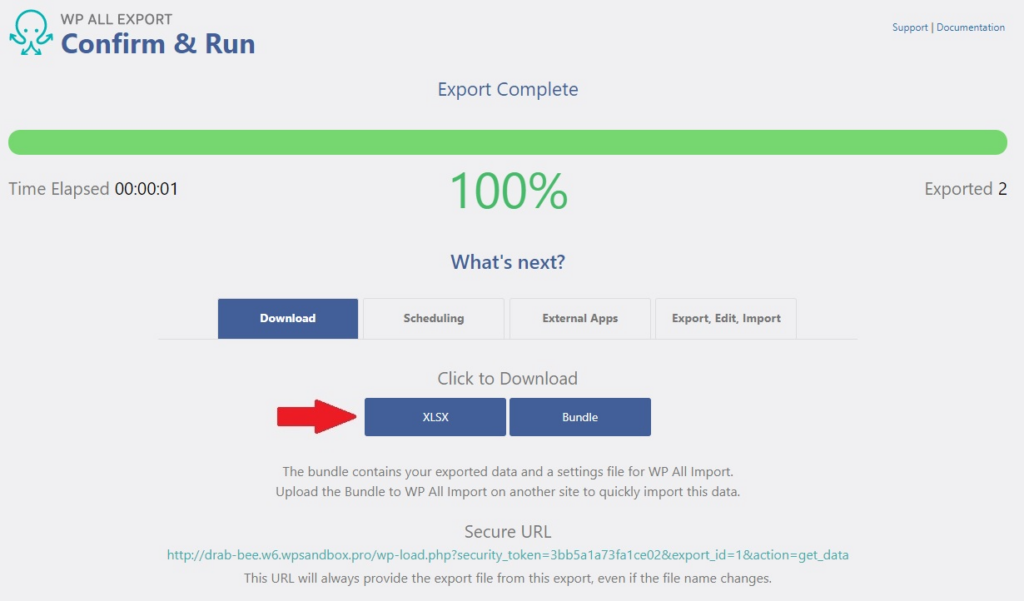
You will be presented with two download options. Click the XLSX button in the Click to Download section to download your Excel file.
Additionally, there is a Bundle option, which makes it easy to migrate the order data to a new WooCommerce website.
That’s it — you’ve successfully completed your order export in Excel format!
Bonus: Easily Bulk Edit WooCommerce Orders
WP All Export has an equally capable sister plugin, WP All Import, to help you with the import side of the process. This opens up two opportunities:
- You can migrate order data from one WooCommerce site to another.
- Bulk edit the orders and import them back to the same website.
To bulk edit order data, download and open the exported file in your preferred spreadsheet software, such as Microsoft Excel, Google Sheets, or others.
Make the necessary edits and then switch to the Export, Edit, Import tab on the Confirm & Run screen. This will open the New Import screen from WP All Import, where you can upload the edited file.
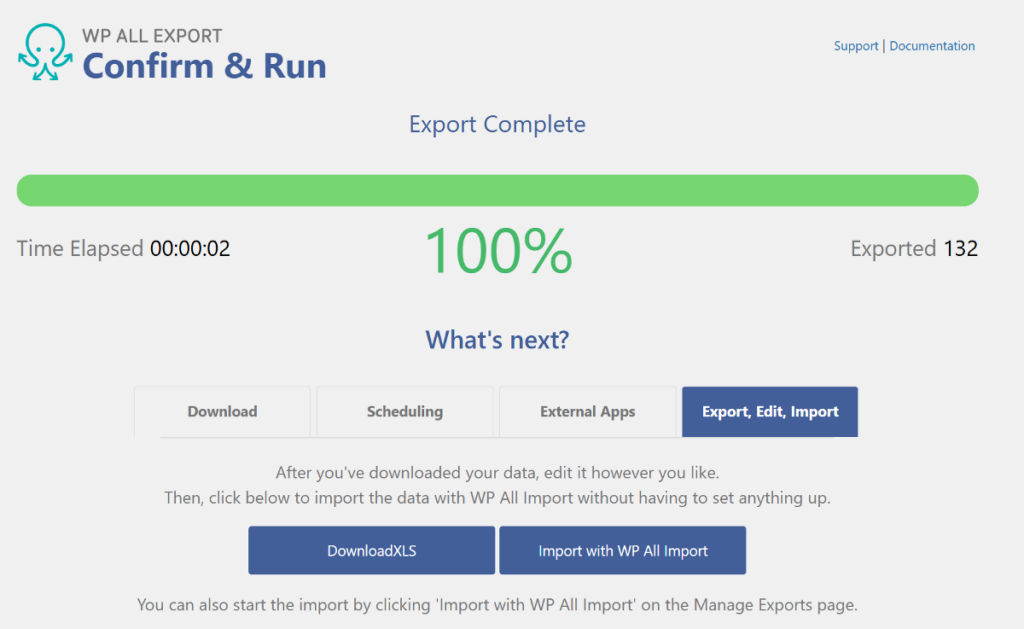
WP All Import will automatically synchronize the data, and the updated details will be reflected in your WordPress dashboard.
Ready to effortlessly export your WooCommerce order data? Download and install the WP All Export plugin today!
Export WooCommerce Orders to Excel – Frequently Asked Questions
Can You Export WooCommerce Orders to Excel?
You can easily export WooCommerce orders to Excel using the WP All Export plugin. Just follow these steps:
- Navigate to All Export › New Export.
- Select WooCommerce Orders as the post type.
- Configure the export columns using our Drag & Drop interface.
- Change the Export Type to Spreadsheet › Excel file.
- Run the export and download your Excel file.
How Do I Download All Products From WooCommerce?
WP All Export supports all WooCommerce data types including products. You can follow the steps below to download all product data from WooCommerce:
- Go to All Import › New Export.
- Select WooCommerce Products as the post type.
- Use the Drag & Drop interface to add product fields.
- Run the export and download your product data.
How To Migrate WooCommerce Orders?
Follow these steps to migrate WooCommerce orders from one site to another:
- Export the WooCommerce orders that you want to migrate using WP All Export.
- Select the Bundle option to download your export file. The bundle file contains an import template in addition to the export data.
- Upload the bundle file on the target site using WP All Import.
- WP All Import will automatically map the order fields based on the bundle file’s import template.
- Review your imported orders.
How Do I Export Everything From WooCommerce?
You can use WP All Export to export everything from WooCommerce. It supports all WooCommerce data types including products, orders, coupons, customers, and reviews.


